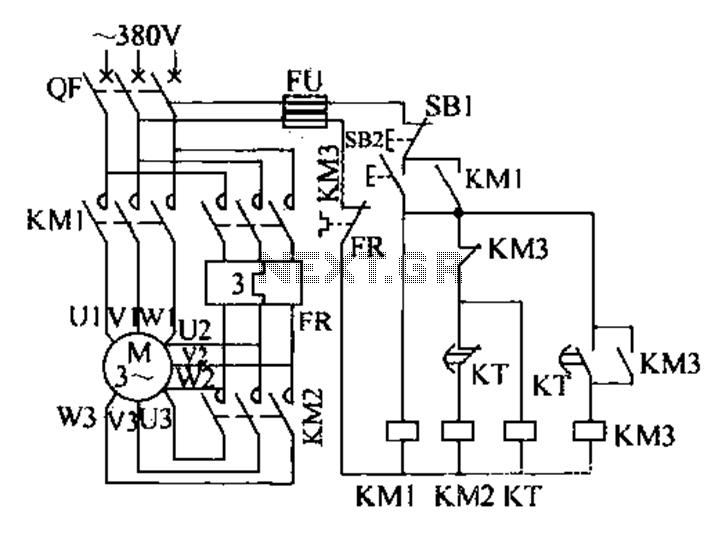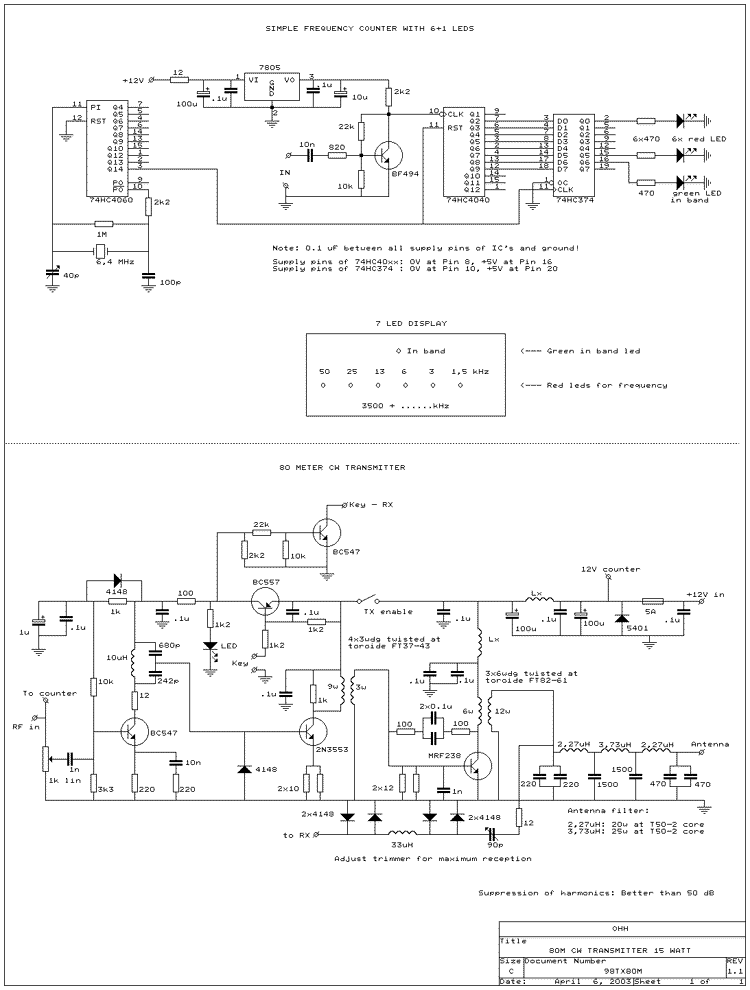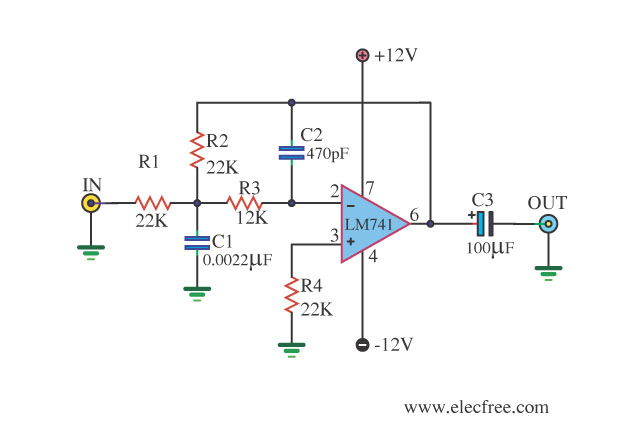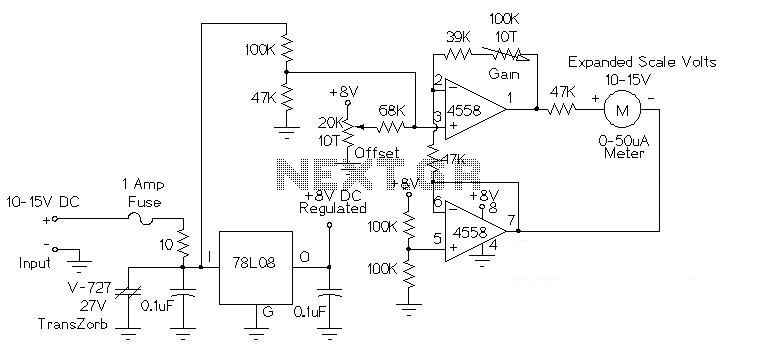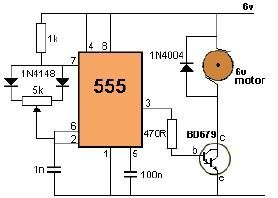
Simple Amplified Field Strength Meter Circuit
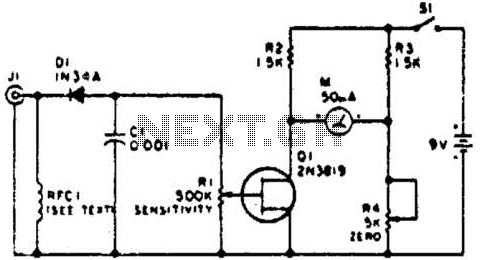
This circuit employs a FET as a DC amplifier within a bridge configuration. Resistor R4 is adjusted for meter nulling with switch J1 short-circuited. Any surplus 50-mA meter can be utilized in this circuit. RFC1 represents a suitable RF choke for the frequency band in use, with a 2.5-mH RF choke being appropriate for broadband operation. Resistor R1 functions as a sensitivity control. The antenna can be any small whip antenna measuring 2 feet or less.
The described circuit functions as a bridge amplifier utilizing a Field Effect Transistor (FET) to amplify DC signals. The bridge configuration allows for precise measurement and nulling of the output, making it suitable for applications requiring high sensitivity and accuracy. The incorporation of R4 as a nulling resistor ensures that the output can be calibrated to zero, facilitating accurate readings regardless of the input variations.
The switch J1, when short-circuited, allows for direct measurement without the influence of any additional resistance that may be introduced by the meter, thus ensuring that the circuit operates within its optimal parameters. The choice of a 50-mA meter is critical as it aligns with the expected output current range, ensuring that the circuit can effectively drive the meter without risking damage from overcurrent.
RFC1, the RF choke, plays an essential role in filtering out unwanted high-frequency signals, allowing only the desired frequency range to pass through. The specification of a 2.5-mH RF choke is indicative of its capability to support broadband operations, making the circuit versatile for various frequency applications.
Resistor R1's function as a sensitivity control is vital for adjusting the gain of the amplifier. By varying the resistance, the user can fine-tune the circuit's response to different input levels, enhancing its adaptability in diverse applications.
The use of a small whip antenna, ideally 2 feet or less, further complements the circuit's design by providing a compact and effective means of signal reception. This type of antenna is particularly suitable for portable applications or environments where space is constrained, ensuring that the circuit remains functional without requiring extensive installation or setup.
Overall, this circuit design exemplifies a practical approach to building a sensitive and adaptable DC amplifier suitable for a range of applications in electronics. This circuit uses a FET as a dc amplifier in a bridge circuit. R4 is set for meter null with J1 short circuited. Any surplus 50-mA meter can serve in this circuit. RFC1 is any suitable RF choke for the band in use. A 2.5-mH RF choke will do for broadband operation. R1 is a sensitivity control. The antenna can be any small whip antenna (2 ft or less). 🔗 External reference
The described circuit functions as a bridge amplifier utilizing a Field Effect Transistor (FET) to amplify DC signals. The bridge configuration allows for precise measurement and nulling of the output, making it suitable for applications requiring high sensitivity and accuracy. The incorporation of R4 as a nulling resistor ensures that the output can be calibrated to zero, facilitating accurate readings regardless of the input variations.
The switch J1, when short-circuited, allows for direct measurement without the influence of any additional resistance that may be introduced by the meter, thus ensuring that the circuit operates within its optimal parameters. The choice of a 50-mA meter is critical as it aligns with the expected output current range, ensuring that the circuit can effectively drive the meter without risking damage from overcurrent.
RFC1, the RF choke, plays an essential role in filtering out unwanted high-frequency signals, allowing only the desired frequency range to pass through. The specification of a 2.5-mH RF choke is indicative of its capability to support broadband operations, making the circuit versatile for various frequency applications.
Resistor R1's function as a sensitivity control is vital for adjusting the gain of the amplifier. By varying the resistance, the user can fine-tune the circuit's response to different input levels, enhancing its adaptability in diverse applications.
The use of a small whip antenna, ideally 2 feet or less, further complements the circuit's design by providing a compact and effective means of signal reception. This type of antenna is particularly suitable for portable applications or environments where space is constrained, ensuring that the circuit remains functional without requiring extensive installation or setup.
Overall, this circuit design exemplifies a practical approach to building a sensitive and adaptable DC amplifier suitable for a range of applications in electronics. This circuit uses a FET as a dc amplifier in a bridge circuit. R4 is set for meter null with J1 short circuited. Any surplus 50-mA meter can serve in this circuit. RFC1 is any suitable RF choke for the band in use. A 2.5-mH RF choke will do for broadband operation. R1 is a sensitivity control. The antenna can be any small whip antenna (2 ft or less). 🔗 External reference
Warning: include(partials/cookie-banner.php): Failed to open stream: Permission denied in /var/www/html/nextgr/view-circuit.php on line 713
Warning: include(): Failed opening 'partials/cookie-banner.php' for inclusion (include_path='.:/usr/share/php') in /var/www/html/nextgr/view-circuit.php on line 713
